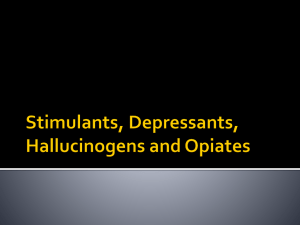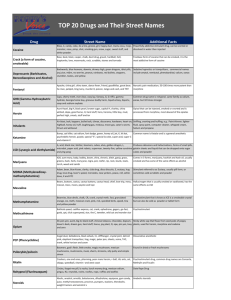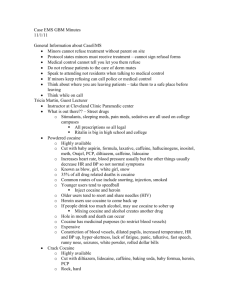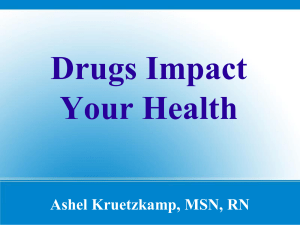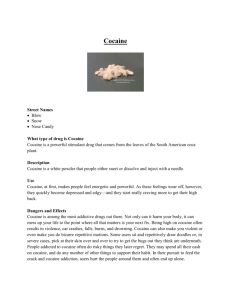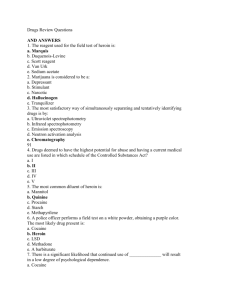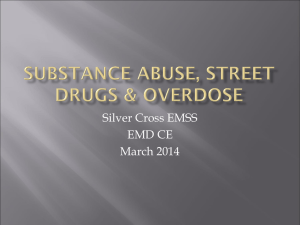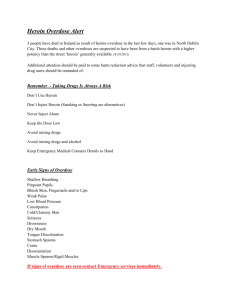Alcohol and Drugs - The Evergreen State College
advertisement
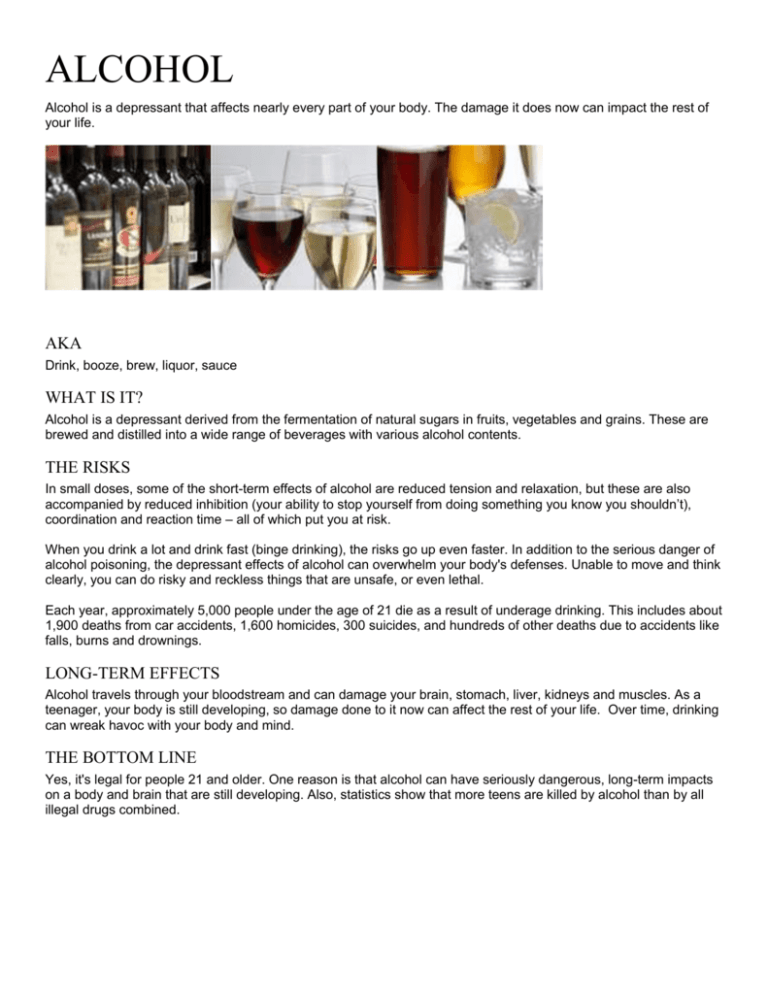
ALCOHOL Alcohol is a depressant that affects nearly every part of your body. The damage it does now can impact the rest of your life. AKA Drink, booze, brew, liquor, sauce WHAT IS IT? Alcohol is a depressant derived from the fermentation of natural sugars in fruits, vegetables and grains. These are brewed and distilled into a wide range of beverages with various alcohol contents. THE RISKS In small doses, some of the short-term effects of alcohol are reduced tension and relaxation, but these are also accompanied by reduced inhibition (your ability to stop yourself from doing something you know you shouldn’t), coordination and reaction time – all of which put you at risk.1 When you drink a lot and drink fast (binge drinking), the risks go up even faster. In addition to the serious danger of alcohol poisoning, the depressant effects of alcohol can overwhelm your body's defenses. Unable to move and think clearly, you can do risky and reckless things that are unsafe, or even lethal. Each year, approximately 5,000 people under the age of 21 die as a result of underage drinking. This includes about 1,900 deaths from car accidents, 1,600 homicides, 300 suicides, and hundreds of other deaths due to accidents like falls, burns and drownings.3 LONG-TERM EFFECTS Alcohol travels through your bloodstream and can damage your brain, stomach, liver, kidneys and muscles. As a teenager, your body is still developing, so damage done to it now can affect the rest of your life.3 Over time, drinking can wreak havoc with your body and mind. THE BOTTOM LINE Yes, it's legal for people 21 and older. One reason is that alcohol can have seriously dangerous, long-term impacts on a body and brain that are still developing. Also, statistics show that more teens are killed by alcohol than by all illegal drugs combined.1 COCAINE Cocaine is a highly addictive drug that can be risky even the first time you use it. Common side effects include increased heart rate and blood pressure, but seizures, cardiac arrest and even death are real dangers. AKA Blow, bump, C, candy, Charlie, coke, snow WHAT IS IT? Powder cocaine is a hydrochloride salt derived from processed extracts of the leaves of the coca plant. "Crack" is a type of processed cocaine that is formed into a rock-like crystal.12 THE RISKS Cocaine is a powerful stimulant, which means it might keep you wired, but not without major risks. Cocaine causes your blood vessels to constrict immediately, increasing your heart rate, blood pressure and body temperature.12 At first, this may make you sweaty and shaky, but seizures, cardiac arrest and even death are real risks. The risk of sudden death is even greater when cocaine is combined with alcohol.12 LONG-TERM EFFECTS Cocaine, like most drugs of abuse, targets and overstimulates your brain’s natural reward system. While this may result in the drug’s pleasurable effects, over time it can actually change the way your brain works, teaching you to repeat the behavior.12 In other words, cocaine can be highly addictive. And smoking it, in the form of “crack,” increases the risk of addiction because it gets into your brain even faster. Binge-pattern use – taking the drug repeatedly and at higher doses in a short period of time – can lead to irritability and anxiety. Abusers may even experience temporary states of paranoid psychosis.12 Prolonged cocaine snorting can irritate and cause scabs to form on your mucus membranes, damage your nasal septum (the thin wall that separates your left and right nostrils) and eventually make your nose collapse. THE BOTTOM LINE Using cocaine or crack-even only once—is dangerous, and the more you use, the worse the effects are on your brain and heart. Continued use can make you depressed, agitated and manic. Cocaine-related deaths are often caused by cardiac arrest or seizures, followed by respiratory failure (meaning, you stop breathing).1 ECSTASY Ecstasy has a rep for being a party drug, but side effects like tremors, muscle cramps and nausea, not to mention anxiety and depression, aren’t much fun. Ecstasy also carries the risk of longer-term brain damage. AKA XTC, X, E, Adam, Eve, clarity, hug, beans, love drug, lovers' speed, peace, uppers, Molly WHAT IS IT? Ecstasy's scientific name is MDMA (methylenedioxy-methamphetamine). It is a synthetic, mind-altering drug that acts both as a stimulant and a hallucinogenic. However, research shows that Ecstasy tablets can contain a number of other drugs that can be dangerous when combined, including methamphetamine, ketamine, cocaine, DXM and the diet drug ephedrine. 19 THE RISKS Like any other stimulant, Ecstasy will increase your heart rate and blood pressure. Other physical effects include tremors, muscle cramps, nausea, faintness, chills, sweating and blurred vision. People who use ecstasy are also at risk of dehydration, which may not seem like a big deal, but by interfering with the body’s ability to regulate its temperature, it puts you at risk of dangerous, sometimes fatal, overheating.21 Shortly after taking Ecstasy, you may also feel confusion, depression and severe anxiety—but these psychological effects have also been reported to occur days or weeks after taking the drug.19 LONG-TERM EFFECTS Ecstasy directly affects the brain chemical serotonin, and how your brain cells communicate with each other. Clinical studies show that Ecstasy can be harmful to your brain and can increase the risk of long-term problems with memory and learning.20 Also, taking too much Ecstasy can interfere with the body's ability to regulate its temperature. This can cause hyperthermia and can lead to liver, kidney and cardiovascular failure.20 THE BOTTOM LINE People will claim that Ecstasy lets you get in touch with all your senses. But what you might really "get in touch with" is the sensation of shaking, cramps, nausea, sweating and blurred vision-now, plus the risk of long-term harm to your brain. HALLUCINOGENS Hallucinogens disrupt the normal functioning of your brain, making it hard to think, communicate and focus on reality. Psychosis, panic attacks and dangerous accidents are all possible risks. WHAT IS IT? Hallucinogens are drugs that distort the way you perceive reality. They can cause you to see, feel and hear things that don't exist, making it hard to communicate or think clearly. They can also cause rapid, intense emotional mood swings.25 Hallucinogens work by disrupting how your nerve cells and the neurotransmitter serotonin interact throughout the brain and spinal cord.25 By changing the normal, healthy structure of serotonin in the body, hallucinogens twist and alter the way your brain processes your senses, feelings and visual information, loosening your grip on reality. The most common hallucinogens are: LSD (AKA: Acid, blotter, cubes, microdot, yellow sunshine, blue heaven, Cid) — an odorless, colorless chemical that comes from ergot, a fungus that grows on grains. Mushrooms (Psilocybin) (AKA: Simple Simon, shrooms, silly putty, sherms, musk, boomers) — psilocybin is the hallucinogenic chemical found in approximately 190 species of edible mushrooms. Mescaline (AKA: Cactus, cactus buttons, cactus joint, mesc, mescal, mese, mezc, moon, musk, topi) — occurs naturally in certain types of cactus plants, including the peyote cactus. THE RISKS Taking any hallucinogens can cause you to experience anxiety, fear and paranoia, sometimes verging on psychosis (a complete loss of contact with reality). In this state of mind, it can be very easy to have a dangerous, or even fatal, accident. LONG-TERM EFFECTS Though more common with LSD, all hallucinogens can cause flashbacks—feelings and thoughts that replay the effects of being on the drug weeks or even years after taking them. Since all hallucinogens disturb the normal functioning of the brain, they put you at risk of developing long-lasting psychoses or mental disorders. THE BOTTOM LINE The effects of hallucinogenic drugs are highly unpredictable. They depend on the amount taken and on your own unique personality and brain chemistry. And regardless of the effects being sought, these drugs almost always impair judgment, compounding their unpredictability, and making you vulnerable to dangerous or even fatal situations, in addition to the longer-term risks to your mental health. HEROIN Heroin is a highly addictive drug. And overdose is a real, and deadly risk. AKA Smack, horse, brown sugar, dope, H, junk, skag, skunk, white horse, China white, Mexican black tar WHAT IS IT? Heroin is an opiate, a class of drugs that are either naturally derived from the flowers of the poppy plant, or synthetic substitutes. In the case of heroin, it’s produced from morphine, a naturally occurring substance that comes from the seedpod of poppy plants. All opiate abuse, including heroin and many prescription drugs carry a strong risk of addiction and physical dependence. Heroin is abused by injecting, snorting or smoking it, and all three can cause the same level of addiction, as well as serious health problems.28 THE RISKS Heroin enters the brain very quickly, making it particularly addictive. It's estimated that almost one-fourth of the people who try heroin become addicted.28 And over time, heroin users develop a tolerance, meaning that more and more of the drug is needed to achieve the same results. It is extremely easy to not only become addicted, but to become physically dependent on heroin as well.29 Physical dependence occurs when your body adapts to the drug’s presence, causing withdrawal – symptoms include muscle and bone pain, diarrhea and vomiting – when use stops. Chronic heroin users can begin experiencing withdrawal in as little as a few hours. Heroin suppresses breathing, which is why using heroin always carries the risk of overdose and death.28 Also, heroin often has additives that will not dissolve in the bloodstream. This can easily cause a blood clot to form and travel to the lungs, liver, heart or brain, which is instantly fatal. LONG-TERM EFFECTS In a short amount of time, regular heroin use destroys the body. Common conditions that plague heroin users include infection of the heart lining and valves, liver disease, lung disease, and hepatitis and HIV/AIDS from needle use. THE BOTTOM LINE It’s a fast high, but just as quickly, it can take over your life, and become fatal. Heroin and other opiate addictions are treatable, but the path to recovery requires a commitment that can often last years or even decades. MARIJUANA Marijuana is at the center of a passionate debate, and there are often exaggerated, or even false claims made by those on each of the opposing sides. What matters is knowing the facts, and they can be difficult to find in the middle of so much hype. Regardless of changing laws, or its potential role in developing new medical treatments, marijuana use has risks, especially if you are a teen. AKA Blunt, dope, ganja, grass, herb, joint, bud, Mary Jane, pot, reefer, green, trees, smoke, skunk, weed, hash, tea, chronic, loud THE RISKS THC acts on specific targets in the brain, called cannabinoid receptors. Ordinarily, these receptors are activated by brain chemicals similar to THC that are part of a neural communication system, and play an important role in brain development and function. Marijuana over activates this system, causing impaired coordination, difficulty with thinking and problem solving, and disrupted learning and memory.39 Your brain goes through significant development during your teen and young adult years, and marijuana’s effects on the developing brain create risks unique to that time period. Following marijuana use, a teen’s decrease in cognitive abilities can last much longer than an adult’s, as long as several weeks since last use. With regular use (daily or nearly daily), the alterations to the brain caused by marijuana can become chronic, and lead to weakened verbal communication skills, lowered learning capabilities and a shortened attention span.40 There is also an association between chronic marijuana use and mental illness. A link has been demonstrated with later development of psychosis, and the risk increases for those who start young. Associations have also been found with other mental health problems such as depression, anxiety, and suicidal thoughts among adolescents, although more research is needed to better understand these connections.39 LONG-TERM EFFECTS Marijuana can be addictive – it affects the brain’s reward centers in similar ways as all other addictive substances40 – and the likelihood of addiction increases considerably for those who start young.39When marijuana use becomes daily, or nearly daily, alterations to the brain can lead to an inability to perceive any negative impact.40 In addition to the possible effects on your cognitive development and mental health, marijuana smoke is an irritant to the lungs, and frequent marijuana smokers can develop many of the same respiratory problems as tobacco smokers, such as daily cough and phlegm production, more frequent acute chest illness, and a greater risk of chest infections.39 THE BOTTOM LINE Marijuana has the potential to cause problems in your daily life, or make existing problems worse. It limits your brain's effectiveness, slows down thinking, and impairs coordination and judgment. And while you're young and still maturing, marijuana can have a long-lasting, negative impact on your developing brain. METH Highly addictive and toxic to the brain, meth will give you a high that can damage your body and brain for life. AKA Meth, ice, crank, chalk, crystal, fire, glass, go fast, speed, Tina, T WHAT IS IT? Meth, or methamphetamine, is a powerfully addictive stimulant that is both long-lasting and toxic to the brain. Its chemistry is similar to speed (amphetamine), but meth has far more dangerous effects on the body's central nervous system. Meth has a high potential for abuse and may lead to severe psychological or physical dependence. THE RISKS Like cocaine and speed, even small amounts of meth can cause a rapid and/or irregular heartbeat, increased blood pressure and elevated body temperatures. These symptoms, especially when meth is taken at high doses, can cause death from stroke, heart attack or organ failure due to overheating.46 Meth works by severely changing the way the brain functions. First, it increases the release of the brain chemical dopamine. At the same time, it blocks the brain from absorbing the dopamine released. Studies show that alterations in the brain’s dopamine system are associated with reduced motor skills and impaired verbal skills.47 LONG-TERM EFFECTS Meth is a highly addictive drug— and repeated use can negatively affect your body and brain. Abuse can cause extreme weight loss, dental problems (“meth mouth”), and lead to sores and scabs on your skin and face. Chronic meth abusers can become anxious and violent. Meth users often display a range of psychotic behaviors, including paranoia, hallucinations, and delusions. One of the most common meth delusions is the feeling of insects crawling under the skin. THE BOTTOM LINE Meth is powerfully addictive and damaging to your body and brain. Getting hooked could leave you with paranoia and delusions, “meth mouth” and skin sores, and risking long-term harm to your brain or death OVER-THE-COUNTER DRUGS Just because you can buy over-the-counter (OTC) drugs with few restrictions, doesn't mean they can’t be dangerous, or even deadly, when abused. WHAT IS IT? Over-the-counter (OTC) drugs are products that are available at supermarkets, drugstores and convenience stores. There is an incorrect but widespread belief that because you don't need a prescription, these drugs must be less dangerous than those found behind the pharmacy counter. The fact is, it’s risky to abuse either. The most commonly abused OTC drugs include those that contain the ingredient DXM(dextromethorphan), which is used to treat cough, cold and flu symptoms. Also, OTC medications believed to help with weight loss — like laxatives, diuretics and diet pills — are sometimes abused. All of these medications can have serious and potentially fatal side effects over time. THE RISKS Both liquid cough syrups and the tablet or capsule forms of medicine that contain DXM can distort your visual perceptions and damage your sense of judgment. High doses can lead to loss of coordination, dizziness, nausea, hot flashes and hallucinations. With diet pills, it sometimes starts by trying just a few, but then can quickly turn into a full addiction. Ephedrine is one of the dangerous stimulants that can be found in diet pills. But even herbal or "natural" weight-loss products can often contain this and other ingredients that may be just as dangerous. Among the many possible side effects of diet pills are hair loss, insomnia, menstrual cycle disturbances, urinary tract infections, diarrhea, vomiting, blurred vision and anxiety. LONG-TERM EFFECTS DXM can be so physically debilitating, it makes any activity potentially dangerous. When combined with alcohol or other drugs, it can lead to overdose and death.17 The stimulants found in diet pills affect the central nervous system, increase your metabolism and make your heart beat faster. This can be especially serious for anyone with a pre-existing heart problem or high blood pressure. But even in a healthy person, diet pills can eventually cause a heart attack or stroke. THE BOTTOM LINE Since they're legal and easy to find, OTC drugs are also easy to abuse. Like any medicine, they can have their benefits when taken as directed and in moderation. But there's always the danger of taking too much, mixing them with other drugs and even overdosing. They can damage your body for life, and even cause death. PAINKILLERS AKA Captain Cody, Cody, sizzurp, lean, syrup, schoolboy, doors & fours, loads, oxy, oxycotton, oxycet, hillbilly heroin, percs WHAT IS IT? Prescription painkillers often contain opioids that are either naturally derived from poppy flowers, or a lab-made, semisynthetic substitute. These drugs attach to particular sites in the brain called opioid receptors, which carry messages to the brain. When you take prescription painkillers, the message the brain receives is changed, so that pain is no longer perceived as painful.53 These are the same receptors that heroin binds to in the brain. Under a doctor's direction, painkillers can be vital in relieving severe pain due to physical damage, cancer or other illnesses.53 Unfortunately, abusing painkillers has become a serious problem.54 The most commonly abused brand-name painkillers include Vicodin, Oxycodone, OxyContin and Percocet. Codeine, an opioid painkiller often found in prescription cough syrup, is also commonly abused. THE RISK Prescription painkillers are powerful drugs that can be dangerous, or even deadly, especially when taken at high doses or combined with alcohol. A single large dose can cause breathing difficulty that can lead to death. The short-term effects of painkiller abuse can include lack of energy, inability to concentrate, nausea and vomiting. LONG-TERM EFFECTS Because of their effect on the brain, prescription painkillers can be highly addictive when used for non-medical purposes. Even patients who are prescribed painkillers for a long time can develop a "physical dependence," meaning that the body becomes accustomed to having the drug. Stopping the drug abruptly can cause severe withdrawal symptoms, so, any changes when using these medications must be reported to and carefully monitored by a doctor.55 THE BOTTOM LINE Painkillers are among the most commonly abused prescription drugs. Without a doctor's prescription and supervision, short- and long-term use of prescription painkillers can lead to dangerous side effects, including accidental overdose. Combining them with alcohol or other drugs increases the risk of death from overdose. TOBACCO & NICOTINE Tobacco is a carrier for the highly addictive drug nicotine. Once your body gets a taste for nicotine, it can quickly become a life-long addiction, with extremely fatal consequences. AKA (Cigarettes) smokes, cigs or butts. (Smokeless tobacco) chew, dip, spit tobacco, snus or snuff THE RISKS Whether smoked or chewed, nicotine is one of the most highly addictive drugs used in today's society. And once you're hooked, it's extremely hard to overcome this addiction.65 Surveys have shown that most adult smokers first tried cigarettes during their teen years, and there is a direct relationship between early smoking and adult addiction. Smoking harms your immune system and can affect nearly every organ of your body.65, 72 The nicotine gets you hooked, but it’s the other chemicals in tobacco like carbon monoxide, tar, formaldehyde, cyanide and ammonia that cause the major damage--many of these are known carcinogens (cancer-causing poisons).67 Carbon monoxide keeps red blood cells from getting the full load of oxygen needed for healthy cellular growth. This encourages the carcinogens in tobacco to bind to the cells throughout your body and cause cellular damage.65, 72 Chewing or sniffing tobacco is just as dangerous as smoking and also has a high risk of addiction. And prolonged use of smokeless tobacco leads to a high risk of cancers of the mouth. Bidis and hookahs have become popular alternatives to smoking cigarettes, and some people seem to think they are less harmful than regular cigarettes. The truth is that hookah smoke still delivers addictive nicotine, and bidis actually have more nicotine than cigarettes. LONG-TERM EFFECTS You probably already know that the greatest long-term risk of smoking is cancer and lung disease. Here are some numbers to consider: In the 40 years between 1964 and 2004, cigarette smoking caused an estimated 12 million deaths, including 4.1 million deaths from cancer, 5.5 million deaths from cardiovascular disease, 1.1 million deaths from respiratory disease and 94,000 infant deaths related to mothers smoking during pregnancy. Even after 30 years of warnings on packages, tobacco continues to impact our health. In 2010, more than 220,000 new cases of lung cancer were reported, and more than 150,000 Americans died as a direct result of the disease.68 THE BOTTOM LINE Smoking tobacco and smokeless tobacco are both carriers of the highly addictive drug nicotine. Once your body gets a taste for nicotine, it can easily become a life-long addiction, with highly fatal consequences. Although quitting can be difficult at any age, the good news is that by giving up tobacco for life, you can drastically improve your health and reduce your risk of cancer, heart disease and other life-threatening diseases associated with tobacco use. Abovetheinfluence.com

